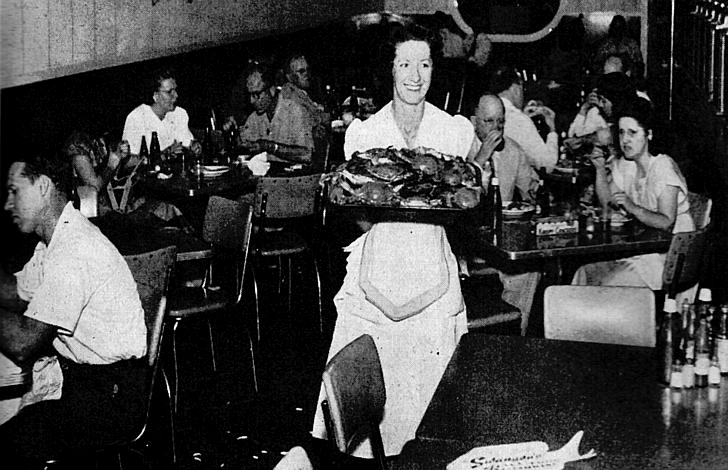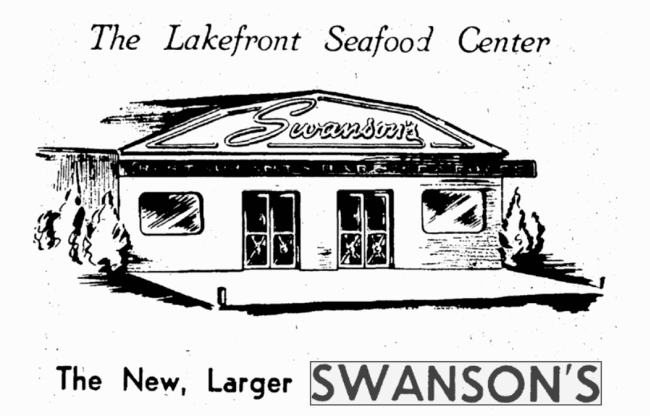|
Today in New Orleans History |
|
|
October 8

 To receive an update for each day in New Orleans history,
join our facebook page - Today in New
Orleans History.
In 1922 Frank William Turan Swanson opened the Yellow Dog Saloon at East End on the lake (near his waterfront home) serving
all the boiled seafood one could eat as long as one imbibed in his ten-cent schooners of beer. In 1926 he opened Swanson's
Sea Food Restaurant whose floor was clearly marked with a line designating which half of the building was located in Jefferson
Parish where gambling was illegal but mostly ignored by local authorities. He fished and hunted to supply the restaurant
in which his wife Julia Pfeiffer worked. A May 1948 fire destroyed the restaurant and the neighboring My-O-My Club (Bruning's had minor damage). Frank and Julia
rebuilt the business which became so popular that celebrities such as Guy Lombardo dined there. By 1953 Swanson's boasted
of “Delicious seafood in air-conditioned bliss”. Frank passed away in 1956 at the age of 64. As a youth he had
been an outstanding swimmer with the East End Athletic Club and had hunted ducks and snipe for market, bringing large bags
of birds to buyers at East End who shipped the goods far and wide. He was known as one of the best marksmen in the area and
widely acknowledged as an outstanding fisherman – one of the first to catch a tarpon within city limits on Lake Pontchartrain.
He also served the community as deputy sheriff and operated the Bucktown jail. The Swansons had lived at 1849 Orpheum Street. In 1968 Vincent Aiavolasiti took over the restaurant and added “aged K.C. Steaks and
authenitc Italian food”. In 1975 Bill Summers stepped in and renamed it “Swanson's Flagship”. The restaurant
returned to Swanson ownership in 1978 when Danny Mayer, grandson of Frank and Julia, bought the business. When Danny passed
away in 1979 the doors were closed for good – Five years later, on Monday, October 8, 1984 the building burned
to the ground. Over 100 firefighters (30 from Jefferson and 80 from Orleans Parish) fought the blaze (Swanson's straddled
the parish line). The alarm was called in my Mable Swann, cashier at Original Bruning's restauant. across Roadway Drive
from Swanson's. Amelia Urrate, owner of Brunings, whose home was across the 17th Street Canal, reported a "ball
of fire" coming through the roof of Swanson's. Her son, Sam Urrate, ran across the pedestrian (gap) bridge but
the fire was already out of control. Firefighters brought the blaze under controll at 5:30 but it flared again when
after a gas line broke. Fire Chief William McCrossen said his men did an outstanding job of containing the fire and
keeping it from spreading to Jaeger's restaurant, only 20 feet away, which suffered littled damage and Papa Roselli's Restaurant
across Roadway Drive. David Mayer, whose family owned the buidling, said it had be closed about five years since the
death of his brother Danny Mayer Jr. who had operated the business. The Swanson family legacy
lives on. In 1975 Frank and Julia's grandson Dennis Lacoste and his wife June opened Dennis' Seafood on Lorino Street, some
4 1/2 miles from the original Swanson's Restaurant. (Images from the Jefferson Parish Yearly Review - Text from Legendary Locals of Metairie)  To receive an update for each day in New Orleans
history, join our facebook page
- Today in New Orleans History
Actress Shirley Rose Prestia (August 18, 1947 – October 8, 2011)
was born in New Orleans and graduated from Mount Carmel
Academy. She guest starred in a number of notable television series including Family Ties, Cheers, St. Elsewhere, The Golden Girls, The Facts of Life, 227, Mr. Belvedere, Babylon
5, L.A. Law, NYPD Blue, Step by Step, The Practice and other series. Prestia also had recurring roles on the sitcoms Home Improvement (as Delores) and Dharma & Greg (as Janet). She appeared in the films Final Analysis (1992), Hoffa (1992), Species (1995), Leave
It to Beaver (1997), Wag the Dog(1997) and What Women Want (2000). (Wiki) Middendorf's beloved restaurant in Akers/Manchac received
little damage from hurricanes Katrina and Rita. On September 14, 2008, however, Hurricane Ike caused a ten foot storm surge on
the western shores of Lake Pontchartrain. This high surge
was the result of Ike's extremely large wind field and the persistent east-southeast winds that drove water into Pass Manchac.
The hurricane was never within 200 miles of the area, yet this was the highest storm surge since the Hurricane of 1915, which destroyed the logging settlements of Frenier and Ruddock along the
western shores of Lake Pontchartrain. At the water's highest point, four feet of water inundated the old restaurant. The
newer Middendorf's building reopened for the first time since the flood on October 8, 2008.
Happy Birthday, Angus Lind Born in New Orleans on October 8, 1944, Angus Miller Lind's byline first appeared in The
Greenie -- the student newspaper of his school, Isidore Newman. He then wrote for the Tulane Hullaballoo.
His first professional job in journalism was as a sports writer for the Meridian Star (Meridian, Mississippi) where he became
the sports editor who covered the Southeastern Conference and the college careers of Archie Manning and Pete Maravich. In December of 1970 he moved back home for good and began working as a general assignment reporter for the
States-Item (the after-noon paper) where he covered (among other top stories) the plane crash of U.S. Representative Hale
Boggs in Alaska, the Downtown Howard Johnson sniper incident, the Rault Center and the Upstairs Lounge fires, and the construction
of the Superdome and unique stories such as alleged vampire and UFO sightings, and the nationally popular streaking phenomena
at Tulane. Regarding his time at the Item, he said, "We worked hard, getting in at the crack of dawn, making three
different deadlines, and then we partied -- almost every day. We all seemed to have the attitude that in New Orleans,
if you die of old age, it's your fault." His first column was published on April 18, 1977, titled
"What's a Yat?", and is generally acknowledged as the first printed account of the expression "Where y'at?".
When the States-Item merged with the Times-Picayune in 1980, Lind stayed onboard and included in his columns real New Orleans
characters, such as "Black Cat" Lacombe, "Leapin' Lou" Messina, Buddy Diliberto (and the "torn
lee knigaments" of Saints quarterback Dave Wilson), Abdul D. Tentmakur, Morgus the Magnificent (Sid Noel) and horse
racing afficandos Hard Times Vince, Cream Cheese Louie, Rooster and The Mullet. His original creations included Deep Float
(distant cousin of Watergate informant Deep Throat) who infiltrated Carnival dens, stole mystic secrets and parade themes,
and leaked them as well as Karnak the Magnificent, who was the keeper of mystic secrets about Tulane and LSU football.
On May 31, 2009, he announced his retirement in his final column titled "Thirty-nine
years and 6,000 columns after he started, Angus Lind holsters his golden quill and rides away". He recalled that
during his long and much loved career, "I met a lot of interesting and colorful and quirky people, and I learned
that they almost all have a story, whether they know it or not." After retiring, Lind authored Prime Angus: Readers' Favorite Columns Reprinted From the Pages of The Times-Picayune
Photo -- West End streetcar on Esplanade Avenue between St. Claude and North Liberty Street, October 8, 1921.
Nicholas Girod (1747–1840) was the fifth mayor of New Orleans between 1812 to 1815 took office
on October 9, 1812. His private residence in the French Quarter is now known as the "Napoleon House".
|
|
|

To receive an update for each day in New Orleans history,
join our facebook page - Today in New
Orleans History.
Analytics |




